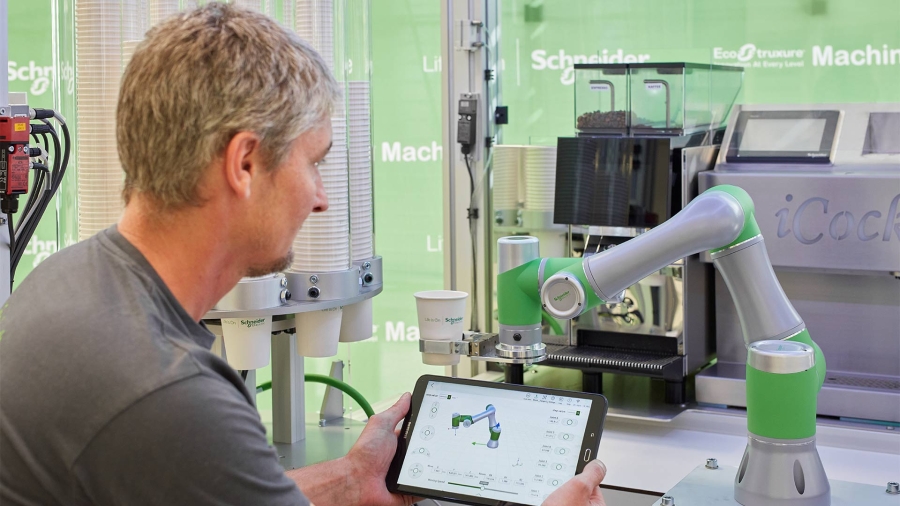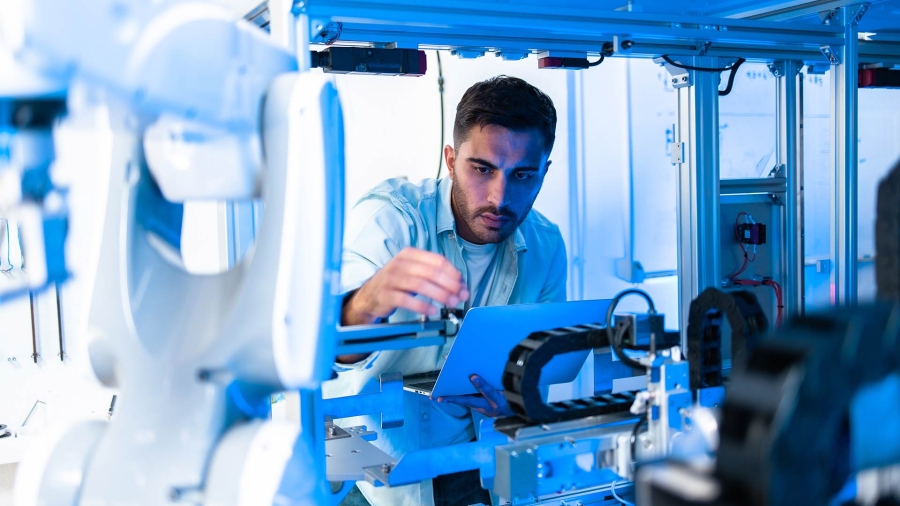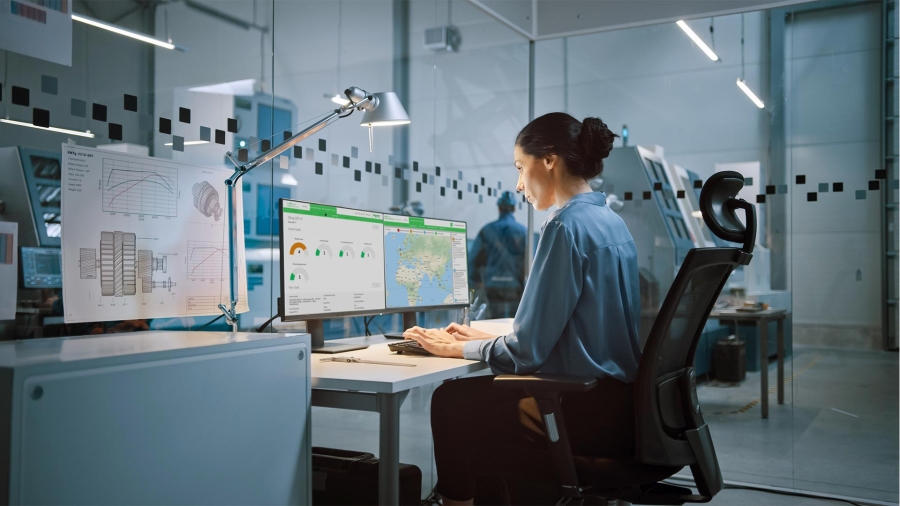“Open the pod bay doors, HAL.”
“The factory of the future will have only two employees, a man and a dog. The man will be there to feed the dog. The dog will be there to keep the man from touching the equipment.” – Warren G. Bennis
That old joke paints an intriguing picture but is this really where industry is heading? Are human industrial workers destined to be replaced by robots and technology? What about artificial intelligence? Are sentient computers displacing humans to the point of the dystopian future predicted in the 1968 film, 2001: A Space Odyssey?
Certainly, the digital transformation of industry is accelerating fast. Pandemic-related and other disruptions have compressed multiple years’ worth of digital transformation into a few months. According to LNS Research, one-half of industrial enterprises report they have embarked on a digital transformation journey, and these programs are yielding real benefits. LNS found that leaders in digital transformation are 72% more likely to have grown revenues by more than 10%, and 57% more likely to have reduced Cost of Goods Sold by more than 10% because of these initiatives. To put it simply, digital works.
Yet, digital transformation is not only about using digital tools to improve the way we currently work. Digital transformation is about fundamentally changing the way we do business. It impacts everything across an organization—from culture and people to processes and business models.
Technology exists to enhance human capabilities
Digital transformation is actually more about people than technology. Technology and software exist to augment and enhance human capabilities and provide safety. They fundamentally improve the way we work and the kind of work we do.
The “manager and his dog” scenario misses an important point: Only humans can change the rules or break the rules (despite what HAL says). Humans possess unique talents compared to machines, including creativity, judgment, life experience, empathy, deep domain expertise, and the ability to improvise, compromise, and innovate. Even the most sophisticated artificial intelligence (AI) is only as good as the person designing and running it. The human workforce remains the most important industrial asset.
There are certainly many scenarios where automation makes a lot of sense, for example, dangerous, repetitive, and low value operations. Automated systems can perform repetitive tasks quickly, reliably, and with less risk. They can also be more efficient and cost-effective compared to manual workers.
Yet, technology is not an alternative to a human workforce; it’s really about human augmentation. For instance, advanced technologies like digital twins and virtual reality allow users to “see” information needed to optimize the operation and maintenance of a plant—easily and safely. Automation also frees humans to focused on the work that only people can do and keeps them safe while doing it.
In its Smart Manufacturing Trends Report: Don’t Forget the People, Forrester notes that “the medium-term future for manufacturing is not one in which people disappear. For manufacturers to attract and retain the talent they’ll need in order to grow, they must champion a future in which technologies augment and empower their human workforce.”
The most successful digitization journeys find the right balance between humans and their digital coworkers. A technology-augmented workforce increases efficiency, productivity, and sustainability.
The future of work
This new era of technology, internet, and remote everything has caused a historic metamorphosis of work, workplace, and workforce. The pace of digital transformation is redefining the very nature of manufacturing jobs, creating new roles and transforming others. In the recent Deloitte report, Creating pathways for tomorrow’s workforce today, 57% of respondents reported using advanced technologies to redesign job tasks.
The same study reported that 75% of industrial organizations identified reskilling the workforce as important or very important for their success, but only 10% said they were very ready to address this trend.
As the next-generation workforce brings with it an engrained digital skillset, proprietary expertise is gradually being replaced by software, artificial intelligence, and autonomous systems that learn and improve over time. The next wave of the workforce will be data engineers responsible for generating positive business outcomes and performance by controlling and automating processes based on real-time information as well as predictive and prescriptive analytics.
Most industrial plant workers already know the answers to the problems they and their companies face. They can become knowledge workers if equipped with the right digital tools to find solutions and the trust to implement them. They can help identify or invent new technologies to improve efficiency and create new business opportunities. Soon, everyone from the top floor to the shop floor will have the necessary digital fluency to make informed decisions and improve company performance.
Here come the digital natives
Millennials and Generation Z have already mastered the technology skills needed to work seamlessly in connected teams using shared data. Growing up in the internet age, they expect automated processes, intuitive user experiences, and a full set of digital tools at their disposal. This is especially important when you consider the Forrester prediction that “demographic changes that underpinned the Great Resignation and the ongoing impact of COVID-19-related absenteeism will continue to constrain the talent market in a tight economy.”
Attracting, retaining, and empowering the best talent is a competitive advantage. People-focused automation creates more engaging workplaces that attract diverse, engaged employees seeking careers in technology-rich environments. Enabling the next-generation workforce with productive, intuitive, and purpose-built technologies not only makes it easier for everyone to perform their jobs but also supports a culture of innovation.
Software makes the invisible visible
The massive amount of data produced by an industrial enterprise, when contextualized and combined with human insight, can be elevated to highly valuable, actionable information. Industrial workers with smart devices and powerful analytics software can make insightful decisions on the fly to optimize operations and fluidly react to—and even anticipate—dynamic conditions.
Unified data brings the entire organization together to quickly align processes, business practices, and even products to ever-changing customer and ecosystem requirements. Industrial software digitally connects people from across disciplines to make better, data-based decisions at every level, from anywhere, and at any time. One example is digitally unifying power and process systems, data, and design to generate improvements across the full lifecycle of an organization. This level of collaboration through unified data is essentially elevating people from operators to decision makers.
AI, cobots, and more
The rise of artificial intelligence and other advanced technologies is driving new levels of efficiency and effectiveness for industrial organizations. Increased collaboration between humans and automation technology is already generating measurable benefits such as increased energy efficiency and faster troubleshooting. Human capability and brain power supported by AI-infused technologies are helping to mitigate business and operational risk, improve workforce safety, and create a more resilient and sustainable enterprise.
Wearables such as smart watches, headsets, and virtual reality goggles combine the best of technology and human expertise. The collaborative robot, or cobot, is also playing an increasingly valuable role. In the past, robots have been used in operations with high frequency, dangerous environments, or heavy loads. While robots are usually kept separate from humans, cobots work alongside humans. With cobots, workers now have intelligent and agile artificial colleagues to gather and share the data needed to drive productivity, quality, and safety.
The most powerful computer
In today’s marketplace, consumer and business demands evolve quickly. The world expects instant responses and fast adaptation, which technology alone cannot provide. In fact, “flexibility/adaptability” was, by far, the workforce trait CXOs said was most critical to their organizations’ futures in the Deloitte Global Resilience Report.
The guiding principle of industrial technology is to augment human capabilities. Machines are best at scaling repetitive tasks quickly and efficiently. Humans are still best at conceptual thinking, decision-making, social flexibility, planning, and ambition. And it will be these skills that a business will use to build scalable systems and sustainable competitive advantages.
To solve real problems, the industries of the future will still need to rely on the most powerful “computer” on the shop floor: humans.














